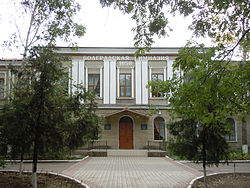Bolhrad High School
| Bolhrad High School | |
|---|---|
 The building of the Bolhrad High School | |
| Location | |
 | |
| , | |
| Coordinates | 45°40′32″N28°36′57″E/ 45.6756°N 28.6157°E |
| Information | |
| Founded | 1858 |
TheGeorgi Sava Rakovski Bolhrad High School(Ukrainian:Болградська гімназія імені Г.С. Раковського,Bolhrads′ka himnaziya im. H.S. Rakovs′koho;Bulgarian:Болградска гимназия „Георги Сава Раковски “,Bolgradska gimnazia „Georgi Sava Rakovski “) is agymnasium(high school) inBolhrad,Odesa Oblast,southwesternUkraine.Founded in 1858 at the request of Bolhrad'sBessarabian Bulgarianpopulation, the Bolhrad Gymnasium is regarded as the oldest high school of theBulgarian National Revival.[1][2]
Bolgrad GlacierinSentinel Range,Antarcticais named after the Bulgarian High School of Bolhrad.
History
[edit]TheRusso-Turkish Warsof the late 18th and early 19th century prompted manyBulgariansto leave theOttoman Empireand settle in the southern domains of theRussian Empireand specifically in theGovernorate of Bessarabia.TheseBessarabian Bulgarians,together withGagauz peoplefounded 43 villages in Bessarabia, as well as the cities of Bolhrad andComrat.As early as 1832, Ukrainian SlavistYuriy Venelinhad suggested that Bolhrad become a centre of Bulgarian culture and education in the Russian Empire; however, the idea was not put into practice at the time.[1]

After theCrimean War(1853–1856),southern Bessarabia(including Bolhrad) came back under the rule of the autonomousPrincipality of Moldavia.In 1857,Nicolae Vogoride,a Moldavian statesman of Bulgarian origin, becameCaimacam(Ottoman-appointed regent) of Moldavia. Bulgarian revolutionaryGeorgi Sava Rakovski,the school's modern patron, personally lobbied in front of Vogoride for the high school's opening. On 10 June 1858 inIași,theCaimacamgranted trust committee members Nikola Parushev and Panayot Grekov a charter permitting the establishment of the high school. The charter outlined the goals which the school's establishment set, as well as some basic rules. The high school was open to all colonists, so long as they were ofEastern Orthodoxconfession. Graduating from the Bolhrad High School would require a total of seven years of education, the first three of which were regarded asprogymnasium,or junior high school.Latin,Bulgarian,Romanian[3]andChurch Slavonicwere part of the curriculum.[1]
The school's own edifice was completed in 1873, when Bolhrad and Moldavia had been absorbed by the largerPrincipality of Romania.The gymnasium was financially independent from state and church, as it relied on income from rents.[3]The first director of the Bolhrad High School was Sava Radulov ofPanagyurishte.Between 1858 and 1879, 685 people enrolled at the gymnasium and 214 graduated; of these 214, 203 were ethnic Bulgarians. Notable students includedAleksandar Malinov,Angel Kanchev,Danail Nikolaev,Dimitar Agura,Dimitar Grekov,Ivan KolevandAleksandar Teodorov-Balan.[1][2]In 1879, after southern Bessarabia reverted once again to theRussian Empire,the school gradually lost its entirely Bulgarian character. A significant part of the students, however, remained Bulgarians, and the Bulgarian language, history and geography have been part of the gymnasium's curriculum for most of its later existence,[1]including today.[3]In 1914, the Russian authorities assigned a Bessarabian Romanian,Ștefan Ciobanu,to a teaching position at the gymnasium. After theRussian Revolution of February 1917,he involved himself in the struggle for Bessarabian autonomy, which resulted in the establishment of aMoldavian Democratic Republicon Governorate territory; at an early stage in this process, Ciobanu also represented the localZemstvoat the Bessarabian Teachers' Congress, where he advocated for a Romanian-centered curriculum.[4]
As a result of the1918 union processBessarabia was included in theKingdom of Romania(or "Greater Romania"). Among those who rejected this new arrangement was Bolhrad alumnusPavel Chioru,who swam across theDniesterinto theSoviet Union,served in theRed Armyand theChekaduring theRussian Civil War,and emerged as a founding figure of the rumpMoldavian Autonomous Soviet Socialist Republic.[5]Bolhrad remained under Romanian rule until theSoviet invasion in June 1940.In the 1920s, the gymnasium, known as the "Bolgrad Lyceum" (Romanian:Liceul din Bolgrad), was touched by controversy, with allegations that its headmasters were cultivatingBulgarian nationalismand actively pushing out Romanian teachers, in connivance with the students.[6]During this second Romanian interval,Vladimir Cavarnali,a poet of mixed Bulgarian and Gagauz heritage,[7]was both an alumnus (1928) and professor (1933–1940).[8]
References
[edit]- ^abcdeManolova, Nadya; Tabakova, Krasimira (2008)."150 години Болградска гимназия"(in Bulgarian). Държавна агенция за българите в чужбина. Archived fromthe originalon April 11, 2009.Retrieved2009-10-19.
- ^abGolovinski, Evgeni V. (2002). "Болградска гимназия „Свети свети Кирил и Методий"".Българска енциклопедия А-Я.BAN.ISBN954-8104-08-3.OCLC163361648.
- ^abcIlychenko, Alena.Болградская гимназия(in Russian). Болградская гимназия. Archived fromthe originalon 2011-08-12.Retrieved2009-10-19.
- ^Bezviconi, Gheorghe (1944). "Academicianul Ștefan Ciobanu la 60 ani".Convorbiri Literare.LXXVII(3): 272–273.
- ^Galushenko, Oleg (2021). "Фольклорист Павел Киор: страницы биографии".Tradiții și procese etnice, 2. 30 martie 2021.Fox Trading SRL. pp. 105–106.ISBN978-9975-3337-8-8.
- ^"Invățământul în sudul Basarabiei. Pe mâna cui e lăsată uneori pregătirea viitorilor cetățeni. — Un caz caracteristic: liceul din Bolgrad".Universul.No. 210. September 15, 1924. p. 1.
- ^Măcriș, Anatol (2008).Găgăuzii.Editura Paco. pp. 104, 128–129.
- ^Burlacu, Alexandru(2010). "Istoria literaturii. Vladimir Cavarnali: poezia faustică".Metaliteratură.X(1–4): 126.
External links
[edit]- Bolhrad High School website(in Russian)(archived version, 2018-07-30)
See also
[edit]- Educational institutions established in 1858
- School buildings completed in 1873
- Buildings and structures in Odesa Oblast
- Schools in Ukraine
- Bessarabian Bulgarians
- History of Moldavia (1822–1859)
- Kingdom of Romania
- Bessarabia Governorate
- 1858 establishments in the Russian Empire
- Secondary schools in Ukraine
- Bolhrad
- History of Bolhrad Raion
